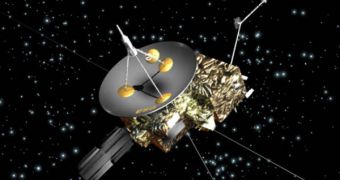The Ulysses robotic space probe is a joint NASA/ESA mission to the Sun, launched on October 6th, 1990, from the space shuttle Discovery, during flight STS-41. The craft's main purpose is to analyze the surface of the Sun from various latitudes, and to determine the interactions that exist within the yellow dwarf. It has been doing this for the past 18 years, but now mission controllers have announced it's time to let it go. Battered by its harsh conditions, the vessel is now only a shadow of its former self, and it will soon run out of full to keep itself warm. Decommissioning is scheduled for July 1st, 2009.
Among the instruments mounted on the spacecraft, the most important are the Radio/Plasma antennas, two, beryllium-copper antennas unreeled outwards from the body, perpendicular to the craft and its spin axis. Their goal is to detect the radio waves generated by plasma moving around the craft. It also features a solid-state X-ray instrument (for solar flare studies), two different magnetometers, as well as detectors for electrons, ions, neutral gas, dust, and cosmic rays.
Ulysses' endurance surprised all those who, year after year, attended to the good functioning of the space probe. Powered by a radioisotope thermoelectric generator (RTG), which produces energy from the natural decay of plutonium, the craft managed to endure all the extreme conditions of outer space for a much longer time than originally planned. It was scheduled to be decommissioned back in mid-2008, when the power output of the engine decreased to such extent, that it threatened the stability of critical internal heaters. These heaters are the only things that prevent the hydrazine fuel that regulates Ulysses' altitude controls from freezing.
“We expected the spacecraft to cease functioning much earlier. Its longevity is a tribute to Ulysses's builders and the people involved in operations over the years. Although it is always hard to take the decision to terminate a mission, we have to accept that the satellite is running out of resources and a controlled switch-off is the best ending,” Space quotes Paolo Ferri as saying. He is the leader of the European Space Agency (ESA) Space Operations Center (ESOC) Solar and Planetary Missions Division.
“Ulysses has taught us far more than we ever expected about the Sun and the way it interacts with the space surrounding it,” ESA Ulysses Project Scientist and Mission Manager Richard Marsden adds. The decision to end the mission was taken by both agencies together, as Ulysses is a collaborative project. Everyone agreed that terminating the satellite on their terms would be a lot better than simply letting it drift away, or simply fall out of the sky.

 14 DAY TRIAL //
14 DAY TRIAL //